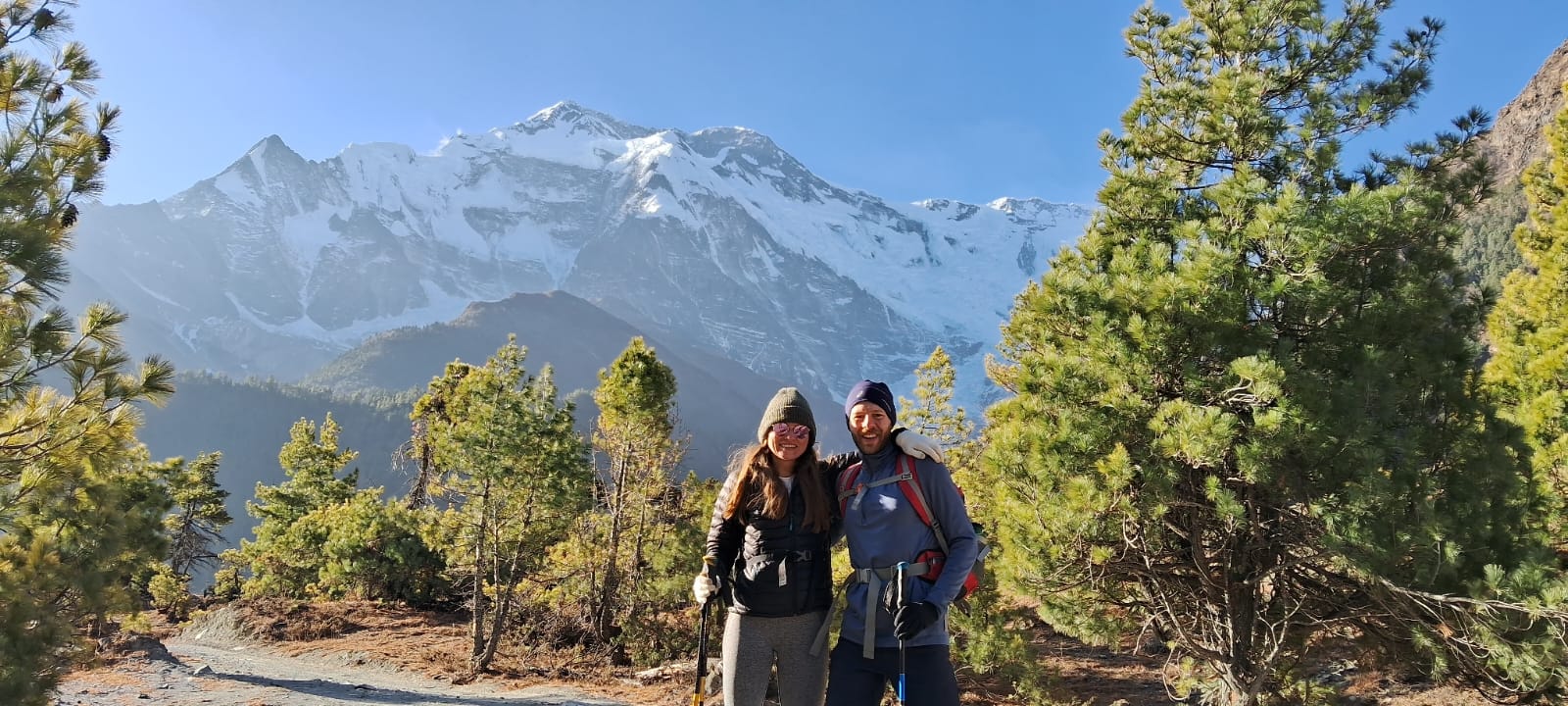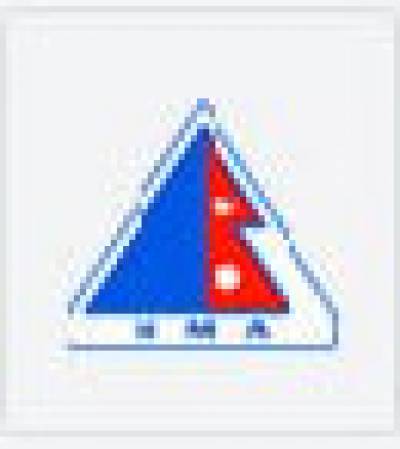ANNAPURNA CIRCUIT TREK 10 DAYS FROM POKHARA
The Annapurna Circuit Trek 10 Days from Pokhara, designed by Sherpa Expedition and Trekking, is a captivating adventure that takes you through some of the most stunning landscapes in Nepal. The trek begins with a scenic drive from Pokhara to Besisahar by local bus. From there, you'll transfer to a shared jeep to reach Chame, the starting point of your trek.
Day 1 marks the beginning of your trek, where you begin your journey from Chame to Upper Pisang. The trail gradually ascends, offering magnificent views of the Annapurna and Manaslu mountain ranges. From Upper Pisang, the vistas become even more spectacular. You will continue your journey to Manang via Ngawal Village, known for its traditional Tibetan-style architecture and breathtaking scenery.
At Manang, you'll take a well-deserved rest day for acclimatization. This day is essential to help your body adjust to the altitude. You can also explore the area by hiking to Lama Cave or Ice Lake, or take a short trek to Yak Kharka to enjoy the surrounding landscape. After the acclimatization day, you’ll continue your trek toward Thorong Phedi, where you may also hike up to High Camp for further acclimatization before descending back to Phedi for rest.
On Day 7, you'll begin early and embark on the challenging ascent to Thorong La Pass (5,416m). After reaching the pass, the trail descends to Muktinath, a sacred site for both Hindus and Buddhists.
Afterward, you’ll take a local bus to Tatopani, a natural hot spring destination, where you can relax and rejuvenate in the warm waters. Day 9 continues with a trek to Ghorepani, followed by an early morning hike to Poon Hill for stunning sunrise views. On the final day, you'll trek down to Nayapul and drive back to Pokhara, marking the end of your unforgettable adventure.
ITINERARY
Day 1 : Drive from Pokhara to Chame (2,760m) – Duration: 9-10 hours.
Your adventure begins with a scenic drive from Pokhara to Chame, the main town in the Manang District. The journey takes about 9-10 hours, passing through winding roads, picturesque villages, and views of the Annapurna Range. Upon arrival at Chame, you’ll get a first glimpse of the mountains and begin to adjust to the higher altitude.
Day 2 : Trek from Chame to Upper Pisang (3,300m) – Duration: 5-6 hours.
Today, you start your trek through pine forests, crossing over a suspension bridge to Bhratang. The trail climbs gradually, offering great views of Lamjung Himal and the surrounding peaks. After a 5-6 hour trek, you reach Upper Pisang, a charming village with panoramic mountain views, including Annapurna II and III. Enjoy the tranquility and beauty of this remote village.
Day 3 : Trek from Pisang to Manang (3,500m) via Ngawal Village – Duration: 8-9 hours.
This long day of trekking takes you through Ngawal Village, offering impressive views of the surrounding mountains. The trail gradually ascends with plenty of opportunities to take in the vistas of the Himalayas. After crossing the high altitude and passing through villages, you reach Manang, a picturesque settlement surrounded by towering peaks. The trek today takes around 8-9 hours, but the views and atmosphere will make it all worthwhile.
Day 4 : Rest Day at Manang for Acclimatization.
Spending a day in Manang is essential for acclimatization before ascending to higher altitudes. Take a short hike around the village to Ice Lake or visit the Lama Cave. This rest day helps your body adjust to the high altitude, reducing the risk of altitude sickness. You can also explore the local culture, visit monasteries, and enjoy the serenity of the mountains.
Day 5 : Trek from Manang to Yak Kharka (4,200m) – Duration: 4-5 hours.
After acclimatizing, it’s time to move on. The trek today is relatively short but takes you to a significantly higher altitude. The trail is rocky and offers splendid views of Annapurna III and Gangapurna. The trail passes through pastures and small settlements, and after 4-5 hours of hiking, you’ll arrive at Yak Kharka, a small village known for its grazing yaks. The landscape here is barren and rugged, with stunning mountain backdrops.
Day 6 : Trek from Yak Kharka to Thorong Phedi (4,600m) – Duration: 3-4 hours.
Today, the trek takes you to Thorong Phedi, the base camp for crossing the Thorong La Pass. The hike is relatively short, but the altitude begins to affect the terrain. The trail ascends through a series of switchbacks, leading you to Thorong Phedi after 3-4 hours of trekking. Upon arrival, you can rest, hydrate, and prepare for the challenging pass crossing tomorrow.
Day 7 : Trek to Muktinath via Thorong La Pass (5,416m) – Duration: 7-8 hours.
This is the longest and most challenging day of the trek. You’ll begin early to ascend to the highest point of the trek, Thorong La Pass (5,416m). The climb is steep, but the views from the top are absolutely breathtaking, offering panoramic vistas of the Annapurna, Dhaulagiri, and Manaslu mountain ranges. After descending from the pass, you’ll reach Muktinath, a sacred site for both Hindus and Buddhists. The trek today takes 7-8 hours, but the experience of reaching the pass is unforgettable.
Day 8 : Drive from Muktinath to Tatopani (1,200m) – Duration: 6-7 hours.
After a challenging but rewarding day, today you’ll descend to Tatopani, a small village known for its natural hot springs. The drive down is scenic, passing through Jomsom, Kagbeni, and other small villages, and takes around 6-7 hours. Once you reach Tatopani, relax in the hot springs and let your muscles recover from the long trek.
Day 9 : Trek from Tatopani to Ghorepani (2,860m) – Duration: 7-8 hours.
From Tatopani, you will trek towards Ghorepani, a village known for its scenic beauty and views of the Dhaulagiri and Annapurna ranges. The day’s trek takes around 7-8 hours and involves a series of steep climbs and descents. You’ll pass through forests, small settlements, and waterfalls, eventually reaching Ghorepani, where you can enjoy stunning views of the surrounding mountains.
Day 10 : Hike to Poon Hill (3,210m) & Trek to Nayapul, Drive to Pokhara (850m) – Duration: 7-9 hours.
On the final day of the trek, you’ll wake up early to hike up to Poon Hill to catch the sunrise over the majestic Himalayas. After soaking in the views, you’ll return to Ghorepani, have breakfast, and then trek to Nayapul. The descent takes about 4-5 hours, passing through lush forests and scenic landscapes. From Nayapul, you’ll take a drive back to Pokhara, where your trek concludes.
SERVICES
Cost Included in Your Package
- Drive from Pokhara to Besisahar by local bus and Besisahar to Chame by local shared Jeep.
- Drive from Muktinath to Tatopani by local bus & Nayapul to Pokhara by private car at the end of the trek.
- Tea House/Lodge accommodation during the trek.
- Three meals a day (Breakfast, Lunch, and Dinner) are provided throughout the trek.
- Experienced and qualified trek leader (guide) with a government license, and an assistant trekking guide for groups of 8 or more trekkers.
- Porter service: One porter for every two trekkers to help carry your luggage.
- Porters' coverage: Their salary, food, accommodation, insurance, and safety equipment.
- The Annapurna Conservation Area Permit (ACAP) fee is included.
- The Trekkers Information Management System (TIMS) card fee is covered.
- Use of trekking gear: Sleeping bag, down jacket, duffel bag, and walking poles (if you don't have your own), to be returned after the trek.
- Assistance with emergency rescue operations (funded by your travel insurance) in case of severe health conditions.
- Sherpa Expedition and Trekking appreciation certificate after completing the trek.
- Oxygen meter to check your pulse, oxygen saturation, and heart rate twice daily, ensuring your health and safety during the trek.
Cost Not Included in Your Package
- International Flight to and from Nepal.
- Nepal entry visa fee: Visas can be obtained easily on arrival at Tribhuvan International Airport, Kathmandu. The fees are as follows:
- $30 USD for a 15-day visa
- $50 USD for a 30-day visa
- $125 USD for a 90-day visa
- Accommodation and meals in Pokhara (other than those provided during the trek).
- Extra night accommodation in Kathmandu or Pokhara due to early arrival, late departure, or early return from trekking for any reason outside the scheduled itinerary.
- Personal expenses such as shopping, snacks, bar bills, tea, coffee, hot water, bottled or boiled water, shower fees, Wi-Fi, laundry, telephone calls, battery recharges, extra porters, etc.
- Personal clothing and gear not provided in the package.
- Travel insurance: It is strongly recommended to have insurance that covers trekking in high-altitude areas.
- Tips for your guide and porters, which is customary in Nepali culture.
- Additional costs or delays caused by circumstances beyond our control, such as landscape changes, bad weather, itinerary modifications for safety, illness, changes in government policy, political instability, strikes, or other unforeseen events.
- NOTE: If you return earlier from the trek due to sickness or any other reason, expenses for flights, hotels, meals, and other services are nonrefundable. You will be responsible for any additional costs incurred in Kathmandu or Pokhara.
EQUIPMENTS
The following information will give you some idea about what you need to bring for the trek. It is important you do not forget the essential items, as this will determine your comfort and safety on the trek. Equally important is that you do not burden yourself with unnecessary equipment on the trek.
- Sleeping Bag (Sherpa Teams will provide but need to return after completing the trip)
- Duffel Bag (Sherpa Teams will provide but need to return after completing the trip)
- Fleece jacket or pullover
- Waterproof windbreaker or windcheater
- Thermal underclothes
- Rain poncho
- Down jacket (Sherpa Teams will provide but need to return after completing the trip)
- Fleece or wool trousers
- Sun hat or scarf
- Trekking pants (two pairs)
- Mittens or woolen gloves
- Hiking socks (several pairs)
- Moisture-wicking shirts, including t-shirts
- Trekking shoes or boots with spare laces
- Flip-flops or sandals for relaxing in the evenings
- Underwear (several pairs)
- Swimsuit or swimming costume
- Sunglasses
- Headlamp or flashlight/torch
- Sleeping bag (Sherpa Teams can provide this for you)
- Trekking poles (if desired)
- Hiking backpack with a capacity of at least 40 liters
- Small lock for your backpack
- Reusable water bottles (at least two liters)
- Water purification tablets or filtration device
- Wash towel
- Basic first aid kit
Toiletries (tissues, toilet paper, moisturizer, lip balm, sunscreen, sanitary pads, hand sanitizer, nail clippers, a small mirror, toothbrush, toothpaste, glasses, contacts, etc.)
GOOD TO KNOW
Trek Difficulty Level 🏔️
The Annapurna Circuit Trek is a moderate to challenging trek. The long trekking hours combined with the high-altitude regions like Thorong La Pass (5,416m) can be physically demanding. While previous trekking experience is helpful, even beginners with good fitness levels can attempt this trek. However, it’s important to take regular rest breaks, stay hydrated, and follow acclimatization guidelines to ensure a successful journey.
2. Best Time to Trek 🌞
The ideal seasons for this trek are spring (March to May) and autumn (September to November). These months provide the best weather, with clear skies, mild temperatures, and minimal rainfall. This makes for a perfect trekking experience, offering spectacular mountain views and comfortable trekking conditions. Winter can be extremely cold, and summer (monsoon season) can bring heavy rain, making the trails slippery and harder to navigate.
3. Acclimatization 🏔️
Acclimatization is a critical part of the trek to avoid Altitude Mountain Sickness (AMS). You will have a rest day in Manang to give your body time to adjust to the increasing altitude. During this day, you can hike to Ice Lake or explore the Lama Cave. Slow and steady trekking is key to maintaining a healthy balance. Make sure to listen to your body and rest if you feel any symptoms of altitude sickness, such as dizziness, headaches, or nausea.
4. Local Transportation 🚍
The trek begins with a local bus ride from Pokhara to Besisahar, which takes about 6-7 hours. From Besisahar, you’ll take a shared jeep to Chame, a small village where your trek starts. The return journey from Muktinath will take you via Tatopani where you can relax in the natural hot springs before continuing to Pokhara via a local bus from Nayapul.
5. Altitude and High Points 🌄
The highest point of the trek is Thorong La Pass (5,416 meters). The trek to this pass is physically demanding, with steep ascents and thin air. The breathtaking views at the top of Annapurna, Dhaulagiri, and Manaslu will make every step worthwhile. Proper acclimatization, adequate hydration, and plenty of rest will help you succeed in reaching this spectacular high point safely.
6. Accommodation 🏠
You will stay in local teahouses and lodges along the trek. While the rooms are basic and shared with other trekkers, the hospitality and warmth make these simple accommodations comfortable. Hot meals are provided, and you can enjoy a variety of dishes, including dal bhat, noodles, and rice. Although amenities such as hot showers and Wi-Fi may be limited in remote areas, these teahouses offer a wonderful opportunity to interact with locals.
7. Food on the Trek 🍽️
During the trek, you’ll enjoy a range of nutritious and filling meals to keep you energized. Typical meals include dal bhat (lentil soup with rice), noodles, vegetables, pasta, and porridge. As you move higher into the mountains, the food options might become more limited, but you’ll still be able to find hearty meals in teahouses. Be sure to eat regularly to maintain energy levels, and drink plenty of water to avoid dehydration.
8. Required Gear 🎒
Proper gear is essential for a successful trek. Trekking boots, rain gear, warm layers, sun protection, sleeping bags, and trekking poles are necessary to ensure comfort and safety throughout the journey. If you don’t have certain items, Sherpa Expedition and Trekking offers equipment for rent, including sleeping bags and walking poles. Always check the weather forecast before you pack, as conditions in the mountains can change unexpectedly.
9. Insurance 🛡️
It is essential to have travel insurance that covers high-altitude trekking and includes emergency evacuation. Many trekking companies, including Sherpa Expedition and Trekking, recommend purchasing insurance that covers things like accidents, medical costs, and trip cancellations. Be sure to carry a copy of your insurance policy with you while trekking for easy access in case of an emergency.
10. Tips for Guides and Porters 💰
It is customary to tip your guide and porter at the end of the trek. The recommended tip is usually between 5-10% of the trek cost, depending on the level of service you receive. These hardworking individuals provide invaluable support during your trek, ensuring your safety and well-being. Tipping is a gesture of appreciation for their hard work, and it helps support their livelihoods.
MAP
PHOTOS/Videos
Departures
Select a departure month
Fill out the form below and a Travel Expert will reach out to create your perfect tour.
FAQS
What is the best time to do the Annapurna Circuit Trek?
The best time to trek the Annapurna Circuit is during spring (March to May) and autumn (September to November). These months offer stable weather, clear skies, and mild temperatures.
Do I need any special permits for this trek?
Yes, you will need two permits: the Annapurna Conservation Area Permit (ACAP) and the Trekkers' Information Management System (TIMS) card. Both can be obtained in Kathmandu or Pokhara.
How difficult is the Annapurna Circuit Trek?
The Annapurna Circuit is considered moderate to challenging. It involves long trekking hours, high-altitude regions, and Thorong La Pass at 5,416 meters. Physical fitness and proper acclimatization are essential for success.
How long does it take to complete the Annapurna Circuit Trek?
The trek typically takes 10-14 days, depending on the route and acclimatization schedule. The trek duration may vary based on weather, your fitness level, and the pace of the group.
Is it safe to trek the Annapurna Circuit?
Yes, the Annapurna Circuit Trek is generally safe. However, like any high-altitude trek, Altitude Mountain Sickness (AMS) is a concern. Acclimatization, staying hydrated, and trekking at a slow pace can help mitigate this risk.
What type of accommodation is available along the trek?
Accommodation along the Annapurna Circuit consists of teahouses and lodges. These are basic but comfortable, providing hot meals, warm rooms, and shared bathrooms.
How should I prepare for the trek?
Preparation involves getting in good physical shape, particularly focusing on endurance and leg strength. Acquiring the proper gear (trekking boots, layers, rain gear) and organizing travel insurance are also important.
Will there be Wi-Fi and phone signal on the trek?
Wi-Fi is available in some villages, but it is often slow and requires a fee. Phone signals are available in larger villages, but coverage may be limited at higher altitudes.
What should I pack for the Annapurna Circuit Trek?
Essential items include trekking boots, warm layers, rain gear, sleeping bags, trekking poles, sun protection, headlamps, and personal hygiene items. Ensure you pack light but efficiently to accommodate the high-altitude conditions.
How much should I tip my guide and porter?
It is customary to tip your guide and porter for their hard work. The recommended tip is between 5-10% of the trek cost, depending on the service quality. It’s a great way to show appreciation for their help during your trek.
Latest Traveller’s Reviews
Travel experiences of our clients who recently returned from their trips.
100%
Based On 5470 Reviews
Emily Zhao
Singapore
May 28, 2025
Professional Trek, Heartfelt Memories – Led by Tshering
I signed up for the Annapurna Base Camp trek with Sherpa Expedition based on a friend’s recommendation, and now I can confidently say it was the best travel decision I’ve ever made. Our guide, Tshering, was truly special. Calm, experienced, and incredibly warm-hearted, he guided us through every step with confidence and care. What I admired most was how he made sure everyone in the group felt supported. Whether it was helping with altitude or simply offering a kind word during steep climbs, he was always there. The trek itself was stunning—every day revealed a new landscape and view. We trekked through rhododendron forests, past rivers and waterfalls, and finally reached the snow-filled amphitheater of Annapurna Base Camp. Sherpa Expedition managed all logistics perfectly—from flights to accommodation to delicious meals at the tea houses. Tshering taught us about the culture, pointed out peaks, and even made us laugh during the tough sections. The views from base camp were beyond anything I’ve ever seen—pure magic. I left Nepal with new friendships and a heart full of gratitude. Thank you, Tshering, and thank you, Sherpa Expedition, for an unforgettable experience.
Laura Petrovic
Canada
May 13, 2025
Absolutely Magical Trek with Guide Dendi
Trekking to Annapurna Base Camp was one of the most magical experiences of my life. Sherpa Expedition made the entire journey smooth and stress-free, and a huge part of that was thanks to our guide, Dendi. His professionalism, combined with his kindness, made him the perfect companion for this adventure. Dendi was extremely knowledgeable and knew the region inside out—he explained the culture, the peaks, and ensured we were adjusting well to the altitude. Every day was an adventure—crossing rivers, walking through thick forest trails, and climbing toward snow-covered landscapes. Sherpa Expedition’s planning was excellent. The flight from Kathmandu to Pokhara was on time, the porters were friendly and hardworking, and the tea houses we stayed in were comfortable and offered surprisingly good food. Dendi checked our health daily, helped with gear issues, and created a supportive group atmosphere. When we finally reached base camp, the sheer beauty brought tears to my eyes. It felt like standing in the heart of nature. This was not just a trek, but an emotional and beautiful journey. I’m thankful to Dendi and the Sherpa Expedition team. I would absolutely recommend this company for anyone looking to experience the Himalayas.
Marcel Mastenbroek
Netherlands
April 9, 2025
Beautiful adventure
My brother and I had a great trip to the Everest Base Camp. Together with Santa our very well informed gide, who took care of us in a fantastic way and gave us much information during the hike, and Gulzen our porter (who carried each day our two bags of 10kg each plus his own bag....unbelievable). We had a wonderful time in the beautiful Himalayas, it was a lifetime experience!
People Considering This Package Right Now Check availability






















